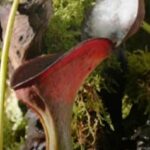As an Amazon Associate, this site earns commissions from qualifying purchases. For more details, click here.
All the feeding and caring that goes into pitcher plants throughout the spring brings up the question, will the plant come back next year? If you want to raise a pitcher plant, knowing its life cycle, behavior and ideal environment will be necessary. This guide will walk you and by the end, you will know what to expect from your pitcher plants.
Pitcher plants like sarracenia are perennial and go dormant during winter. They can survive freezing during winter, but if it gets too cold, put mulch around the roots. Nepenthes pitcher plants do no go through dormancy and must be protected from extreme cold.
Do All Pitcher Plants Go Dormant?
When people talk about pitcher plants, they usually refer to those belonging to the nepenthes or sarracenia family. Nepenthes pitcher plants have over 100 variants and species. There are currently 8 known sarracenia species.
Nepenthes are tropical pitcher plants and do not need dormancy. Sarracenia pitcher plants go dormant during winter, and it lasts 3-5 months. because there are a lot of variants hybrids and cultivars, characteristics vary. But the following overview can give you an idea.
Nepenthes. Nepenthes naturally grows in tropical climates so thy do not need dormancy. They can stay in the same environment throughout the year and will keep growing. Because they prefer tropical weather, you have to protect these pitcher plants during the winter.
Nepenthes should be indoors during winter. Provide at least 50% humidity and 8 hours of light. You may use Aspect LED Grow Lights indoors during the cold season. Keep the temperature at the same level as it is during the growth period from spring to summer.
Even under these circumstances, some nepenthes species will still experience growth slowdowns. This is normal as the lighting is not the same as the sun. However, they will survive. Once spring comes, you can take them outside if you like.
Sarracenia. All sarracenia plants go dormant from November to February. If your pitcher plant is indoors, take it outside or leave it in an unheated part of your house. If the plant is already outside, you can just leave it there.
In nature, sarracenia experience winter freezing at 32 F / 0 C. The plant will be fine under these conditions. If you are worried about too much cold or an extended winter, take in your garage but keep the place unheated. Too much cold is bad, but sarracenia still needs some of it.
After winter ends, the plant will come back from dormancy. Now is a good time to repot or divide the plant. You can propagate sarracenia via leaf and root cuttings.
Why Pitcher Plants Go Dormant
Pitcher plants use a lot of energy from spring to fall. Winter is the perfect time for these plants to take a rest as there is little light available, not to mention prey. Dormancy is to plants what hibernation is to bears. For sarracenia, it is an essential part of the life cycle.
Like all plants, sarracenia are sensitive to changes in temperature. As the cold season slowly comes in, pitcher plants make preparations for dormancy.
Dormancy is not only needed, but practical. There is little light available for one. Nutrients from insects will be harder to come by and water is scarce. Instead of wasting energy trying to grow under these difficult conditions, a pitcher plant will preserve its energy and wait for warmer weather.
As winter approaches, plants shed leaves, stop eating and may actually shrink. The plant looks dead but it is not. It is simply preparing for winter. To conserve energy the plant discards its leaves -which will not survive winter- and will grow new ones in spring.
If sarracenia pitcher plants do not go dormant, its roots, leaves and stem will freeze. The liquids in its pitcher will be frozen and so will its nectar. This is going to cause all kinds of problem and affect its growth and development.
When dormancy ends, sarracenia pitcher plants “wale up” from their hibernation. It might take a few days or several, but eventually the plant will start eating again. If indoors, you can start giving it fish food, mealworms, crickets, flies or even ladybugs.
This cycle will continue throughout the life of sarracenia pitcher plants. Dormancy is absolutely necessary and without it, the plant will not survive. During dormancy, pitcher plants preserve energy so it can return in spring and grow again.
If you have sarracenia, you have to make sure the plant is exposed to the cold weather. It takes patience because dormancy lasts months. But this will pay off after winter ends.
How Do I Know if My Pitcher Plant Will Return?
This is one of the most common questions because during dormancy, a plant looks sickly or dead. You might get alarmed and think the plant will never return. This happens to Venus flytraps as well and it can be difficult to determine whether a pitcher plant is dormant or dying.
Dormant pitcher plants come back from dormancy in spring, but not right away. It might take several days or weeks before it emerges. Rising late from dormancy will not harm pitcher plants, but emerging too early can cause problems.
Winter is characterized by sudden temperature shifts. It could be freezing for a few weeks then a break causes a thaw. The sudden change might force the plant out of its dormancy and produce growth, only to be cut short by another freeze.
This can shorten the lifespan of pitcher plants drastically. By covering the plant with mulch, you can prevent premature ending of dormancy.
When your pitcher plant emerges in the spring, it will slowly resume its normal functions. By using photosynthesis and chlorophyll the plant can produce its own food.
Light, water, air and humidity allow pitcher plants to produce more leaves and traps. In addition, humidity and water allow pitcher plants to create digestive enzymes. In turn this enables the plant to eat more prey. Use only distilled or spring water like Poland Spring Water to ensure the plant remains healthy.
All of this will only be possible if your pitcher plant has had sufficient dormancy. Lengths vary but 3 months is the minimum required. Because it might take a few weeks for the plant to fully emerge, this can last four months.
Tips to Help Pitcher Plants Come Back After Dormancy
Dormancy is only one aspect of growing sarracenia. You have to make sure the other areas are taken care of as well. The following applies to all pitcher plants that go dormant.
Before Dormancy
Pitcher plants will start preparing in middle or late fall, or when the temperature starts dropping continuously. This is to be expected. Trim any brown, black or withered leaves. As dormancy approaches, reduce the amount of water you use.. The soil should still be wet but not as much as before.
if your pitcher plant is outdoors, it should be fine for the rest of winter. if it gets colder than normal, put mulch all over the base. In fact it is a good idea to add mulch in case the opposite happens and there is a sudden thaw.
After Dormancy
Give the plant time to fully recover. This might require a few weeks. Keep an eye on the plant as leaves slowly emerge again. Do not feed it yet. After several days, increase its exposure to spring time light. Sarracenia needs more light than nepenthes so leave it outdoors.
You can also use this time immediately after dormancy to divide sarracenia. You can also repot it or propagate with seeds, leaf or root cuttings.
Check its pitchers to see if has started eating again. If not, there might not be any liquids yet in the pitcher. Increasing humidity will help here. Once liquids appear in the pitcher, it will produce nectar and draw insects.
If your sarracenia is indoors, you have to give it food. But since these plants thrive outdoors, it is better to take them outside. This makes things easier for you too since there are plenty of bugs available.
Conclusion
Nobody wants to see their pitcher plants disappear after just a few months, and they do not have to. With proper care, your sarracenia will make it through the winter and come back in the spring.

My fascination with carnivorous plants began many, many years ago with Venus Fly Traps. Now I am more than happy to impart what I know with other enthusiasts and those who are curious about meat eating plants.



